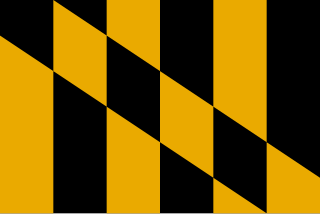
The Province of Maryland was an English and later British colony in North America from 1634 until 1776, when the province was one of the Thirteen Colonies that joined in supporting the American Revolution against Great Britain. In 1781, Maryland was the 13th signatory to the Articles of Confederation. The province's first settlement and capital was in St. Mary's City, located at the southern end of St. Mary's County, a peninsula in the Chesapeake Bay bordered by four tidal rivers.
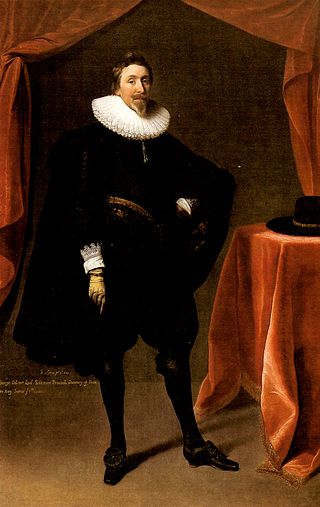
George Calvert, 1st Baron Baltimore was an English politician. He achieved domestic political success as a member of parliament and later Secretary of State under King James I. He lost much of his political power after his support for a failed marriage alliance between Prince Charles and the Spanish House of Habsburg royal family. Rather than continue in politics, he resigned all of his political offices in 1625 except for his position on the Privy Council and declared his Catholicism publicly. He was created Baron Baltimore in the Peerage of Ireland upon his resignation. Baltimore Manor was located in County Longford, Ireland.
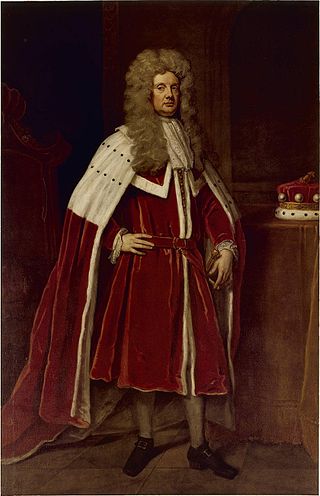
Charles Calvert, 3rd Baron Baltimore was an English colonial administrator. He inherited the province of Maryland in 1675 upon the death of his father, Cecil Calvert, 2nd Baron Baltimore. He had been his father's Deputy Governor since 1661 when he arrived in the colony at the age of 24. However, Charles left Maryland for England in 1684 and would never return. The events following the Glorious Revolution in England in 1688 would cost Calvert his title to Maryland; in 1689 the royal charter to the colony was withdrawn, leading to direct rule by the British Crown. Calvert's political problems were largely caused by his Roman Catholic faith which was at odds with the established Church of England.

Benedict Leonard Calvert, 4th Baron Baltimore was an English colonial administrator and politician who represented Harwich in the House of Commons of Great Britain from 1714 to 1715. He was the second son of Charles Calvert, 3rd Baron Baltimore and Jane Lowe, and became his father's heir upon the death of his elder brother Cecil in 1681.
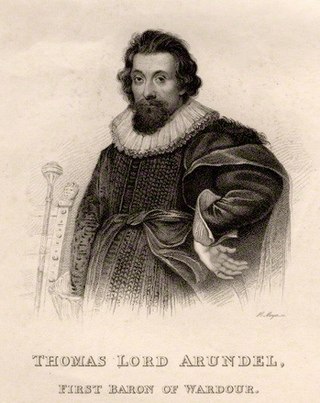
Thomas Arundell, 1st Baron Arundell of Wardour was the eldest son of Sir Matthew Arundell of Wardour Castle in Wiltshire, and Margaret Willoughby, the daughter of Sir Henry Willoughby, of Wollaton, Nottinghamshire, and wife Margaret Markham. He distinguished himself in battle against the Ottoman Turks in the service of the Emperor Rudolf II, and was created a Count of the Holy Roman Empire. His assumption of the title displeased Queen Elizabeth, who refused to recognize it, and imprisoned him in the Fleet Prison. In 1605 Arundell was created 1st Baron Arundell of Wardour. In the same year, he was briefly suspected of complicity in the Gunpowder Plot.
John Coode is best known for leading a rebellion that overthrew Maryland's colonial government in 1689. He participated in four separate uprisings and briefly served as Maryland's governor (1689–1691) as the 1st Leader of the Protestant Associators.
Josias Fendall(c. 1628 – c. 1687) was an English colonial administrator who served as the Proprietary Governor of Maryland. He was born in England, and came to the Province of Maryland. He was the progenitor of the Fendall family in America.

Colonel Thomas Brooke Jr. of Brookefield was President of the Council in Maryland and acting 13th Proprietary Governor of the Province of Maryland. He was the son of Major Thomas Brooke Sr. and Esquire and his second wife Eleanor Hatton who later remarried Col. Henry Darnall. He was grandson of the Reverend Robert Brooke Sr., who had similarly held the office briefly during the Cromwellian period in 1652.

Major Thomas Brooke Sr., Esq. was a colonial lawyer, planter and politician of Calvert County, Maryland, where he served in the appointed positions of Burgess, High Sheriff and Chief Justice.
Robert Brooke Sr. (1602–1655) was a Colonial Governor of Maryland for several months in 1652. He is also the grandfather of later colonial Governor of Maryland Thomas Brooke Jr.
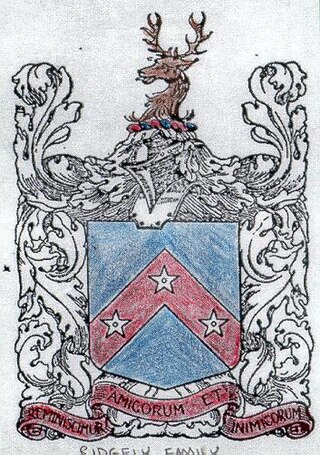
Col. Charles Ridgely II, "Charles The Merchant" (1702–1772), of "Ridgely's Whim", was a Justice, planter, merchant, ironmaster, and member of the General Assembly of Maryland's lower chamber, House of Delegates and one of Baltimore County's commissioners. Charles II was the son of Charles Ridgely I,, , and Deborah Dorsey, daughter of Hon. John Dorsey.
William Joseph was the 11th Proprietary Governor of Maryland from 1688 to 1689. He was appointed by the colony's proprietor Charles Calvert, 3rd Baron Baltimore. Joseph attempted to maintain control of the colony in the proprietor's name, but religious turmoil related to the Glorious Revolution in England led to Joseph's being removed from office by Protestant colonists and the Calvert family losing control of the colony.

Charles Carroll, sometimes called Charles Carroll the Settler to differentiate him from his son and grandson, was an Irish-born planter and lawyer who spent most of his life in the English Province of Maryland. Carroll, a Catholic, is best known for his efforts to hold office in the Protestant-dominated colony which eventually resulted in the disfranchisement of Maryland's Catholics. The second son of Irish Catholic parents, Carroll was educated in France as a lawyer before returning to England, where he pursued the first steps in a legal career. Before that career developed, he secured a position as Attorney General of the young colony of Maryland. Its founder George Calvert, 1st Baron Baltimore and his descendants intended it as a refuge for persecuted Catholics.

Colonel Henry Darnall was an Irish-born planter, militia officer and politician who served as the chancellor of Maryland from 1683 to 1689. He was also appointed as the proprietary agent for Charles Calvert, 3rd Baron Baltimore and also briefly served as deputy governor of Maryland. During the 1689 Protestant Revolution, his proprietarial army was defeated by Protestant rebels led by John Coode, and Darnall was stripped of his numerous colonial offices as a result. He died in 1711, leaving the bulk of his substantial estates to his son, Henry Darnall II.
Colonel William Digges was a prominent planter, soldier and politician in the Colony of Virginia and Province of Maryland. The eldest son of Edward Digges (1620-1674/5), who sat on the Virginia Governor's Council for two decades but died shortly before Bacon's Rebellion, Digges fled to Maryland where he married Lord Calvert's stepdaughter and served on the Maryland Proprietary Council until losing his office in 1689 during the Protestant Revolution, when a Puritan revolt upset the Calvert Proprietorship. His eldest son Edward sold his primary Virginia plantation to his uncle Dudley Digges. It is now within Naval Station Yorktown. His former Maryland estate, Warburton Manor, is now within Fort Washington Park. Two additional related men with the same name served in the Virginia General Assembly, both descended from this man's uncle and his grandson Cole Digges (burgess): William Digges (burgess) and his nephew and son-in-law William Digges Jr. both represented now-defunct Warwick County, Virginia.

The Protestant Revolution, also known Coode's Rebellion after one of its leaders, John Coode, took place in the summer of 1689 in the English Province of Maryland when Protestants, by then a substantial majority in the colony, revolted against the proprietary government led by the Catholic Charles Calvert, 3rd Baron Baltimore.
Francis Southwell was auditor of the exchequer under Henry VIII and a Member (MP) of the Parliament of England for St. Albans in 1558. He was the third son of Francis Southwell and Dorothy, daughter and co-heiress of William Tendring. His elder brothers were Sir Richard Southwell (1502/3–1564) and the lawyer Sir Robert Southwell of Mereworth in Kent. A fourth brother, Anthony, married Anne Le Strange, daughter of Sir Thomas Le Strange.
Henry Darnall II (1682-1759) was a wealthy Roman Catholic planter in Colonial Maryland. He was the son of the politician and planter Henry Darnall, who was the Proprietary Agent of Charles Calvert, 3rd Baron Baltimore, and served for a time as Deputy Governor of the Province. During the Protestant Revolution of 1689, Henry Darnall I's proprietarial army was defeated by the Puritan army of Colonel John Coode, and he was stripped of his numerous colonial offices. After his father's death, Henry Darnall II did not enjoy political power in Maryland, but he remained wealthy thanks to his family's extensive estates. He married twice, fathering many children. His eldest son Henry Darnall III (c1702-c1783) inherited the bulk of what remained of his estates, and one of his grandchildren, Daniel Carroll, would become one of the Founding Fathers of the United States. A small portion of Darnall's former property, now called Darnall's Chance, can still be visited today.

Henry Darnall III was a wealthy planter in Colonial Maryland. He was the son of the politician and planter Henry Darnall II, and the grandson of Henry Darnall who was the Proprietary Agent of Charles Calvert, 3rd Baron Baltimore (1605–1675), and served for a time as Deputy Governor of the Province. Henry Darnall III converted to Anglicanism and entered politics at a time when the Calvert family had regained their proprietary colony, having lost it during the Protestant Revolution of 1689. Darnall received much criticism for his faith and was accused of being a secret Catholic. Worse, in 1761 he was accused of embezzling almost £1,000 thanks to his position as Naval Officer of the colony, and was forced to flee Maryland for Europe in order to avoid being placed on trial.
Colonel Henry Lowe (1652-1717) was a planter, soldier and politician in Colonial Maryland. Born in Denby in Derbyshire in 1652, in 1674 Lowe sailed to Calvert County, Maryland where he was granted land by Lord Baltimore, and by 1695 had settled in St. Mary's County, Maryland. Lowe was an active member of the Maryland Provincial Assembly. He served in the Lower House of the Colonial Legislature in St. Mary's City, Maryland from 1701 to 1704. He also served as the Naval Officer for Patuxent from 1684 to 1685, as Justice of the Provincial Court from 1694 to 1697, and held a number of other colonial offices. He died in around 1717 in St. Mary's City, Maryland.











